Sausage, weenies, wurst, párky, klobása, saucisson, salumi: understanding and navigating the vast world of wurst!
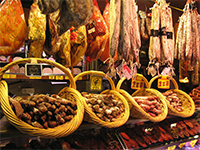 |
In the wurst-eating world, three main categories are recognized based on how the meat is treated during the preparation process. This is a German system and, like German knives or German cars, it is very well thought through, yet simple and full of common sense. Based on this system, sausages can be into those that are somehow thermally treated before stuffing in the casing (Brühwurst and Kochwurst), and Rohwurst, which are sausages that are either delivered completely raw (i.e. raw bratwurst for grilling), or are preserved with various agents and aged or smoked (i.e. salami or cured kolbasz from Hungary or from the Alps).
The English language fall hopelessly short here and translates all of them collectively as sausage. It therefore appears necessary to use the German terms to properly navigate through this essay, as well as through the world of wurst.
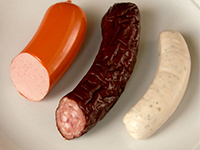 Examples of Brühwurst. |
- all the weenies (Wiener Würstchen, Frankfurter Würstchen, Strassburger Würstchen, Frankfurter Rindswurst - classic weenies, to an American)
- the bockwurst from Berlin, Polish kielbasa (i.e. the krakowska kielbasa in Poland or krakauer in Germany - same thing), Czech klobása, and the soft varieties of Hungarian kolbász (i.e. lecsókolbász and debreceni kolbász)
- the German knackwurst (i.e. the regensburger knackwurst), Austrian extrawurst, krainer, käsekrainer
- the lyoner from Lyon
- the Mortadella from Bologna (don't call it "baloney"...)
- the Munich weisswurst
- various delicacies intended to be eaten cold such as bierwurst, bierschinken, schinkenwurst, jagdwurst, braunschweiger etc.
- cervelat from France, Switzerland or Germany
- meat loaf
Based on size and grain, several sub-categories are recognized:
- Brühwürstchen (thin wurst i.e. Wiener Würstchen and Frankfurter Würstchen, Debreziner Würstchen, Bockwurst)
- Fine-grained Brühwürst (Munich weisswurst, mortadella, lyoner)
- Coarse-grained Brühwürst (jagdwurst, schinkenwurst, bierwurst, krakauer, burenwurst, krainer)
- Brühwürst with additives (bierschinken, käsekrainer)
Brühwurst accounts for 60 % of all sausages produced In Germany.
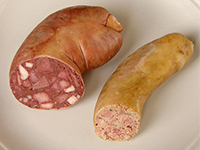 Examples of Kochwurst. |
The second difference is in what holds them together. Kochwursts, after being stuffed into the casing, are simmered in 80° c water, during which time germs are killed and the bonding develops. The wurst is held together by solidified fat, jelly (Sulz) or coagulated protein. As a result, kochwursts are not as firm and cut-resistant, unline brühwursts. Kochwursts is typically boiled or smoked after insertion into the casing.. Some Kochwursts (i.e. liver and blood sausages) are often still cold-smoked after simmering, more taste and longer shelf life.
Examples of Kochwurst include:
- Blutwurst
- Corned Beef, Spam, as well as - believe it or not - the pâté. Pâté would be refered to as Pastete in Germany or by its close relative, the Leberwurst.
- Presswurst (sülze, tlačenka, hogshead cheese)
Kochwursts are mostly intedded for cold consumption with various condiments.
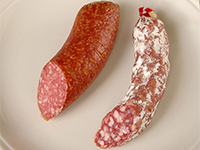 Examples of Rohwurst. |
- Certain types of hard Hungarian kolbász (i.e. Csabai kolbász)
- The thin kaminwurz and landjäger from Austria
- Cabanossi
- The entire universe of salami:
- Italian varieties such as Genovese, Milanese, Pepperoni, Soppressata, Finocchiona, Cacciatore
- Chorizo from Spain
- Saucisson sec from France
- German salami
- Hungarian Winter Salami (Téliszalámi)
Salami is cured sausage, fermented and air-dried meat, originating from one or a variety of animals.
Cured rohwursts are first finely ground, although not minced as finely as in Brühwurst, and mixed with various conservation agents such as saltpeter. After inservion into casing, the fermentation process starts, during which bacteria convert sugars into lactic acid, increasing the acidity of the environment, thus preserving the meat. Aging takes places in climate-controlled plants, caves, cellars etc. The final sausages are often cold-smoked at the end.
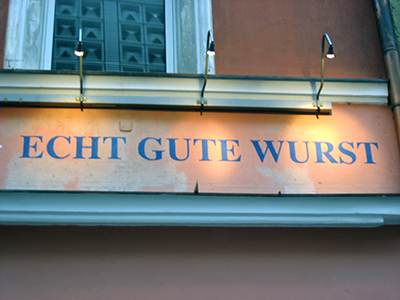
Sources:
- Exhibit "Sousedé na talíři, Die Nachbarn auf dem Teller" held 2011 - August 2011 in Brno, Czech Republic
- Nuernberginfos.de
- Fleischtheke.info
- Würstchen.de
- Wurstakademie.com
- Wurst.de
- Wikipedia
back to Radim and Lisa's Well-Travelled Cookbook | email us
Last updated: May 10, 2014
Certain images from Wikimedia Commons, used under the terms of the GNU Free Documentation License.
Certain images from Rezeptewiki.org, used under the terms of the Creativecommons.org License.